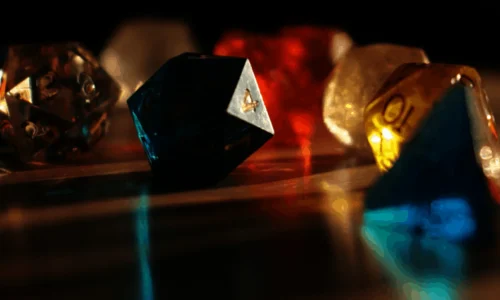Lava is a dangerous and deadly substance in the world of Dungeons and Dragons. It can be encountered in volcanic environments, underground caverns, and other hazardous locations. In D&D 5th edition, there are specific rules for lava damage, including rules for movement, damage, saving throws, and equipment damage.
These rules are important for players and DMs to understand in order to properly navigate and survive encounters with lava.
Lava Rules
Lava is a hazardous substance that can cause significant damage to characters who come into contact with it. In D&D 5th edition, there are specific rules for lava damage that dictate how it affects characters and their equipment.
Movement in Lava: The first aspect of lava damage rules is movement. Characters may need to move across lava or swim through it, and there are rules for how to do so safely.
Walking on Lava: Walking on lava requires a Dexterity check, with a DC determined by the DM. Failure can result in significant damage to the character.
Swimming in Lava: Swimming in lava is even more dangerous and requires a constitution check. Again, failure can result in significant damage to the character.
Damage from Lava: The second aspect of lava damage rules is the damage it can cause to characters.
Initial Damage: Characters who come into contact with lava take initial damage, with the amount determined by the DM based on the circumstances.
Ongoing Damage: Characters who remain in contact with lava suffer ongoing damage, which is also determined by the DM.
Saving Throws: In order to avoid or reduce the damage from lava, characters can make saving throws.
Dexterity Saving Throws: Dexterity saving throws can be used to avoid initial damage from lava or to reduce ongoing damage.
Constitution Saving Throws: Constitution saving throws can be used to avoid or reduce ongoing damage from lava.
Immunity and Resistance to Fire Damage: Some creatures may be immune to or resistant to fire damage, which can affect how much damage they take from lava.
Damage to Equipment: Exposure to lava or other sources of fire damage can also cause damage to a character’s equipment in D&D. This damage can be significant, and can impact a character’s ability to continue adventuring or to survive future encounters.
Spells and Lava Damage: Finally, there are rules for how spells interact with lava damage, which can provide additional options for characters in these dangerous situations.
Creatures Found Near Lava
Encountering creatures near lava can provide players with an additional layer of challenge and excitement. For example, if a party is exploring a volcanic dungeon, they might have to fight off a group of Magma Mephits while also avoiding lava flows and eruptions.
Alternatively, they might have to negotiate with a Salamander guarding a valuable artifact or passage through a dangerous area. In some cases, creatures like Fire Elementals or Red Dragons might be powerful enough to serve as a primary antagonists for an entire campaign arc.
It can provide an exciting and challenging addition to any D&D campaign and can help to create a sense of danger and urgency for players. DMs should be creative and flexible when designing encounters involving these creatures and should be prepared to adapt to keep the game fun and engaging for everyone involved.
These are just a few examples of creatures that might be encountered near lava in D&D. Each creature has unique abilities that make them well-suited to living in or near these hazardous environments.
Fire Elementals and Magma Mephits are both resistant or immune to fire damage and can move through lava without taking harm. Salamanders are immune to fire damage and can also move through lava unscathed, and they have the ability to wield weapons made of molten rock.
Red Dragons are immune to fire damage as well and can breathe fire, making them formidable foes for any party that encounters them.
Certainly! Here’s a table and some additional information on creatures that can be found near lava in D&D:
| Creature | Description | Abilities |
| Fire Elemental | A being made of living flame, summoned from the Elemental Plane of Fire. | Immune to fire damage, can ignite flammable objects, can move through lava without harm |
| Magma Mephit | A small, impish creature made of molten rock and magma. | Resistance to fire damage, can explode on death, can move through lava without harm |
| Salamander | A humanoid creature with a body of red-hot magma and a fiery temper. | Immune to fire damage, can move through lava without harm, can use weapons made of molten rock |
| Red Dragon | A fearsome dragon with scales the color of molten lava. | Immune to fire damage, can breathe fire, can fly |
| Hell Hound | A fierce, demonic dog with a body of fire and brimstone. | Immune to fire damage, can breathe fire, can track targets by scent |
| Fire Giant | A towering giant with skin the color of lava and a fiery temper. | Immune to fire damage, resistant to non-magical weapons, can hurl boulders |
| Azer | A small, dwarf-like creature made of metal and fire. | Resistance to fire damage, can craft weapons and armor from metal and magma, can create small explosions |
Lava Damage
Lava is one of the most dangerous natural hazards in the world of D&D. Exposure to lava can cause severe burns, as well as suffocation and other physical injuries.
In D&D, characters who come into contact with lava will take damage each round based on the intensity of the heat and the amount of time they spend in contact with it. It’s important for DMs to consider the potential hazards of lava when designing encounters or adventures.
Lava can provide an exciting and dangerous backdrop for exploration and combat It’s important for DMs to communicate the dangers of lava clearly to their players, and to provide opportunities for characters to avoid or mitigate the effects of exposure to it.
For example, characters might be able to use magic to create a barrier between themselves and the lava, or they might be able to use spells or abilities to create a path across the lava without coming into contact with it directly.
With careful planning and consideration, encounters involving lava can be thrilling and memorable additions to any D&D campaign.
These damage values assume that the character is in direct contact with the lava, either by falling into it or walking on its surface.
Characters who are near lava but not in direct contact with it might still take damage from the intense heat but at a reduced rate. Additionally, characters who are resistant or immune to fire damage will take less damage from lava exposure.
The following table outlines the effects of exposure to lava in D&D:
| Exposure Time | Damage per Round |
| Up to 6 seconds | 2d10 fire damage |
| 6 to 30 seconds | 4d10 fire damage |
| 30 seconds to 1 minute | 6d10 fire damage |
| 1 to 3 minutes | 8d10 fire damage |
| 3 minutes or more | 10d10 fire damage |
Effects listed in the table are meant to add some additional realism and consequences to exposure to lava in D&D. For example, characters who are in contact with lava for 30 seconds or more might find that their clothing or equipment begins to catch fire, adding an extra layer of danger and urgency to the situation.
Characters who are exposed to lava for 1 to 3 minutes might begin to suffocate due to the intense heat and smoke, which can make it harder for them to escape or fight back effectively. Characters who are exposed to lava for more than 3 minutes are likely to suffer severe burns and may be at risk of death.
Effects of Weather
Weather can have a significant impact on encounters with lava and can make them even more challenging. Here are some weather effects that can affect lava damage in D&D 5e:
Rain: Rain can help to cool down lava and reduce its damage. However, it can also make surfaces slick and difficult to navigate, increasing the risk of falling into lava.
Wind: Strong winds can cause lava to spread farther and faster, making it more difficult to avoid. Wind can also blow volcanic ash and debris, which can obscure vision and make it harder to see and avoid lava hazards.
Ashfall: Ashfall can occur during volcanic eruptions and can create a layer of ash and debris that covers the ground. This can make it difficult to move quickly or avoid lava pits, as well as potentially causing respiratory problems for characters.
Extreme heat: In areas with active volcanoes or intense lava flow, the heat can be intense even outside of the immediate lava pits. Characters may need to take precautions to avoid heat stroke or other heat-related illnesses.
Earthquakes: Earthquakes can be a common occurrence in areas with active volcanoes and can cause rockslides, cave-ins, and other hazards that can increase the risk of falling into lava or being injured by lava-related debris.
Weather can make encounters with lava even more challenging and should be taken into account by DMs when designing encounters and hazards involving lava. Characters may need to prepare for extreme weather conditions and adjust their strategies and tactics accordingly to survive.
Immunity and Resistance to Fire Damage
In D&D, there are various ways for characters to gain immunity or resistance to fire damage. These abilities can be particularly useful for characters who are likely to encounter lava or other sources of fire damage during their adventures.
Immunity to fire damage means that a character takes no damage from sources of fire, including lava. Resistance to fire damage means that a character takes half damage from sources of fire, including lava.
Some examples of abilities that grant immunity or resistance to fire damage in D&D include:
The spell “Protection from Energy”, allows the target to gain resistance to fire damage (as well as other types of damage) for up to an hour.
The “Elemental Adept” feat, allows a character to ignore resistance to fire damage and treat rolls of 1 on fire damage dice as 2s.
The “Fire Shield” spell, creates a magical shield around the caster that grants resistance to fire damage and deals fire damage to any creature that hits the caster with a melee attack.
The “Potion of Fire Resistance”, grants the drinker resistance to fire damage for one hour.
The “Phoenix Sorcery” subclass for sorcerers, grants the character resistance to fire damage and the ability to regain hit points when they deal fire damage to a creature.
The “Fiendish Resistance” feature for Tieflings grants the character resistance to fire damage.
The Dragonborn race has a natural resistance to fire damage due to their draconic heritage.
Players and DMs should keep in mind that these abilities are not always easy to come by, and may require specific character choices or careful planning in order to obtain.
However, characters who are able to gain immunity or resistance to fire damage will be much better equipped to handle encounters involving lava and other sources of fire damage and may be able to avoid taking as much damage or even survive encounters that would be deadly to characters without such abilities.
Spells and Lava Damage
Spells can be an important tool for characters facing lava damage or other sources of fire damage in D&D. Some spells can be used to protect characters from fire damage or to mitigate the effects of exposure to lava, while others can be used to deal damage to enemies or to create obstacles that impede their progress.
Some examples of spells that can be useful in encounters involving lava or fire damage include:
“Protection from Energy”: This spell can grant a character resistance to fire damage for up to an hour, making them more resistant to the effects of exposure to lava or other sources of fire damage.
“Water Breathing”: This spell can allow characters to breathe underwater or in environments where the air is toxic or dangerous, which can be useful for navigating areas around lava or other hazardous environments.
“Create Water”: This spell can be used to create a pool of water that can be used to extinguish flames or cool down areas that have been exposed to lava.
“Wall of Stone”: This spell can create a barrier of stone that can be used to block off areas exposed to lava or to create obstacles that impede enemy movement.
“Fireball”: This spell can be used to deal significant damage to enemies or to clear a path through obstacles in environments with lava or other sources of fire damage.
“Ice Storm”: This spell can create a hail of ice that deals cold damage to enemies and can also extinguish fires or cool down areas that have been exposed to lava.
Players should choose their spells carefully when facing encounters involving lava or fire damage, taking into account the potential risks and rewards of each spell.
Likewise, DMs should consider the ways in which spells can be used to create interesting and challenging encounters involving lava or other sources of fire damage, while also ensuring that players have a fair chance to succeed and survive.
FAQs
How can DMs use lava damage in their campaigns?
DMs can use lava damage in their campaigns to create challenging encounters and hazards for their players. This can include using lava pits in dungeons or volcanic regions and creating NPCs or monsters that are immune to or resistant to lava damage.
Does fire resistance work on lava?
Fire resistance does work on lava in D&D 5e, but it only provides partial protection. If a character has resistance to fire damage, they would take half the damage from lava.
How can characters avoid lava damage in D&D 5e?
Avoiding lava damage in D&D 5e can be challenging, but characters can use several strategies and abilities to protect themselves like spells, environmental protection, abilities, teamwork and problem solving techniques.
How much damage does lava do in D&D 5e?
In D&D 5e, lava is considered a hazard that deals 10d10 fire damage per round of exposure. This damage is typically enough to kill most characters instantly.







